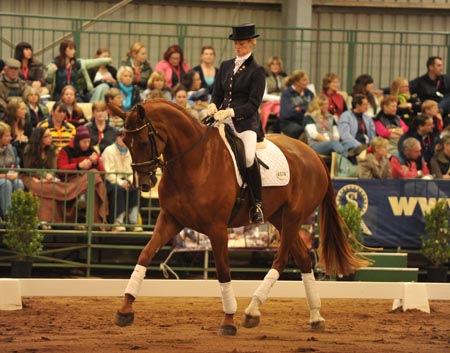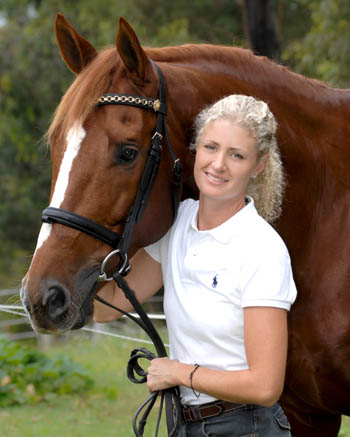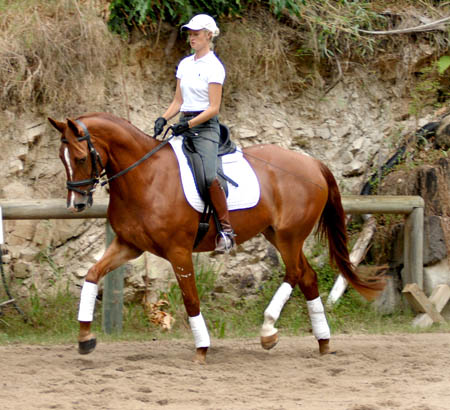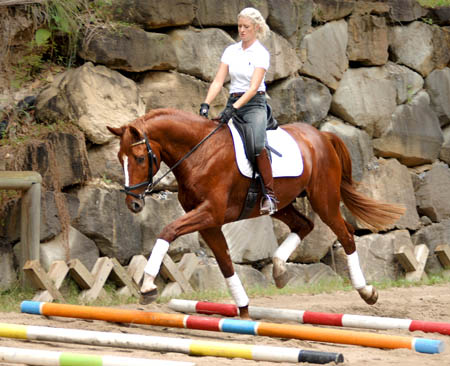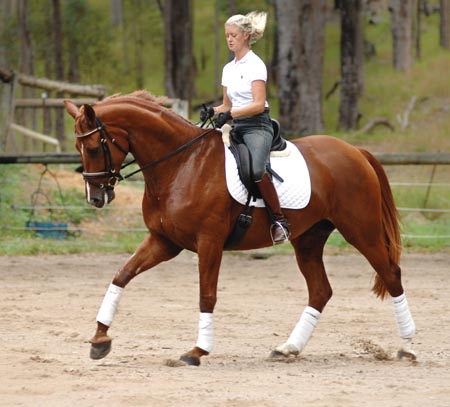Growing up in New Zealand, Sarah Honeywell had Nicole Uphoff and Rembrandt plastered over her schoolbooks. She marvelled at the skill of Isabell Werth, Klaus Balkenhol and Dr Reiner Klimke at the Olympic Games, Sarah’s dream was to ride in Europe.
Her start in riding was like any other. A mischievous pony and a firm instructor saw Sarah winning on the show circuit from the age of three and she caught the bug. From then on it was all about horses: “When I turned 13 I was saying I wanted to make it a career. But my parents were like, ‘You can’t ride horses for a living!’ So I said, ‘I want to be a jockey then, because you can ride a horse and it’s a job.’ And my parents said, ‘Absolutely not!’ As I got older I was itching to go overseas, but my parents wanted me to have a back-up plan, so I did business studies.”
While studying in Christchurch, she took up eventing. Funnily enough, it led Sarah to her first FEI Dressage horse: “I was given an eventing horse to ride by Hilary Holstein, who was a very good dressage rider. Hilary had been asking me if I wanted to ride her old dressage horse for a while, but he had a mane this long (she holds her hands two feet apart) and he was hairy, with long feet. He looked like a wild Friesian basically. Hilary had asked a bunch of people if they wanted to ride him but they took one look at him standing in the paddock and were like, ‘Eh, no thanks.’”
When Hilary’s ‘retired’ dressage horse broke out of the paddock and trotted into the arena, Sarah had a change of heart: “He came trotting out like this, in the air, and I was like, ‘Oh wow.’ After that I wanted to ride him, so Hilary put some shoes on him and I never looked back. He was about Elementary level and I took him up to competing Prix St George, but training Inter II.”
Together Sarah and Vangelis went on to win New Zealand’s National Young Rider Championships in 2000 and were named on the various talent squads. This led to clinics with Clemens Dierks, giving Sarah a push in the right direction: “I didn’t realise you could make a career out of dressage, because there weren’t many people in New Zealand who were. Then Clemens said, ‘I’ll send you overseas’ and I was like, ‘Oh really!’” A plan was hatched that night: “Clemens made a phone call to Belgium and they said, ‘Send her over.’ I left a week later. I had my twenty-first birthday and going away party the weekend after the clinic and left two days later, my parents didn’t have a say, they finally gave up trying to stop me.”
The stable of Stefan Van Ingelgem was Sarah’s first stop: “I learnt a lot about breaking horses in there, and that there’s a planned progression into them becoming a riding horse. If you take the right steps, it’s really not a drama breaking them in.”
Sarah was well suited to the task: “When we first broke them in Stefan would be on the ground and I would be on them, and I had 100% faith in him. Stefan put me on the breakers because fear wasn’t a factor, I sat quiet and I didn’t scare the horse. A lot of people will do too much, they grab at the reins and cling with their legs. But I wasn’t scared because I’d ridden so many mad Thoroughbreds in eventing.”
Many riders struggle to adjust to the workload of a European barn, but Sarah was pursuing her dream and would do anything to prove herself: “Even when I was in New Zealand I would go and live at my instructor’s house during the holidays because I was keen as mustard, I was mad, anything I could do to ride I would do and I idolised anyone who was in dressage. When I got to Stefan’s, sure, it was really hard work, but I thought it was the best thing in the world to be in Europe riding dressage horses.”
It was at Stefan’s barn that Sarah bought her first dressage horse: “After I’d been in Belgium for a year I bought a four-year-old with a friend of mine from New Zealand, Ben Alexander. We doubled our money on it two weeks later. Then we bought a three-year-old by Rubinstein called Ruben James.”
When Ruben James suffered from a hernia it gave them a rocky start: “He had a big colic operation and spent a lot of time recovering so he ended up being a year behind the horses in his age group. I would’ve had to really push him to do the young horse classes, but I was at a competition when he got the hernia, which is created from stress, so I was always a bit worried about competing him.”
They became travel companions instead: “He travelled with me everywhere through Europe from then on and it was time to take another step. I decided to make a move, Stefan was the main rider, and because there was only ever him and his wife, Carmen (De Bondt), they were always busy teaching clients. So I went to PSI to see the Kasselmanns’ and moved to Germany.” The prestigious sales barn was the perfect place for Sarah: “I loved it there. I really like the German style of riding and I liked the family atmosphere there. It was more fun because there was a big group of us. When I was there we had 180 horses in work and I think they have even more than that now.”
Lots of horses meant lots of learning experiences: “You’re exposed to so much and they really teach you how to bring the best out of a horse. Whether it’s a Stallion show or you’re riding the horse for clients, you’re really taught how to present them and train them to be something special.”
Surprisingly Sarah was given more lessons riding for the auction barn: “It was really good because they don’t have many clients coming for lessons, they don’t teach a lot of people apart from their staff, so they had more time for us. Training us is a way of investing in their horses, the better we do, the better their horses do. They can’t ride 180 horses so they have to make sure we’re doing a good job.”
It was also a chance for Sarah to prove herself: “If you can do well with the horses that aren’t the super stars then you get better horses and everybody wants to have the best list of horses.”
This appealed to Sarah’s competitive nature and after making progress with the challenging ones she was given an opportunity: “I actually got what we call the ‘best seat in the house.’ Bianca Kasselmann had the best horses in the stable, amazing horses, and I got to warm them up for her and sometimes work them as well. A particularly memorable one was the stallion Lord Sinclair, but I rode her Grand Prix competition horses too.”
After four years at PSI, Sarah was ready for a change: “I was at the stage where if you stay there you’ll be there for the next twenty years, like you’d never leave, and I was starting to want to have a bit more of a lifestyle.” When Sarah moved to England she became frustrated with the change of pace: “I went there for a couple of months and I couldn’t handle it, I didn’t like it at all. I was used to the German way, where everything is so precise and planned, and it made me a real perfectionist. In England they wanted to ride one horse and then have a cup of tea. I actually got home sick for the Kasselmanns’ so I went back to PSI for a few months.”
Through a connection made at PSI, Sarah took a job riding at Florida’s Winter Show in the United States that runs for three months. Then it was time for another change of scenery, and Sarah was introduced to a different style of riding in Holland: “At the Kasselmanns’ they’d always say, ‘Legs on, legs on, sit deep and put your legs on, ride with your legs.’ When I went to Holland they said, ‘Take your leg off.’ I went, ‘Is this a joke?’ Their system was so different and I just couldn’t get my head around it. The way I’d been riding had been working for me so I needed to find a trainer who suited me.”
This led Sarah to the stables of Anne van Olst, who was part of the Bronze medal winning Danish team in Beijing, and has coached the likes of Hans Peter Minderhoud and Carl Hester: “She’s a very precise trainer, she’s where I learnt more about developing the horse into a Grand Prix mount from a very early age. Not pressurising it to do movements but taking the simple steps that build up to them being an FEI horse, rather than the horse turning eight and the rider going, ‘Oh now we have to piaffe.’”
I watched Sarah ride three horses, two five-year-olds that had started the half steps, and a six-year-old that hadn’t. The strength of the horse dictates the work, not their age: “You feel when they’re strong enough. When they have a good connection to the bit, and they can push from behind while staying straight and steady to the contact, I play around with the half steps. By no means can they hold it but they start to get their head around the rhythm, and they’re thinking about sitting on their hind legs. They start to build strength from that and learn how to use their body better. Then they show themselves better in their working and collected trot.”
This work brings the horse into an uphill frame: “When they’re strong enough behind and straight to the contact, they come up themselves. When they’re not pushing from behind they dive on the forehand. I find if they’re off the leg and engaged they’ll come up in the contact when they’re strong enough.”
For Sarah, feeling the horse do exactly that is what it’s all about: “I’m a perfectionist and I like competing, I did from a young age, but what I really love is the feeling underneath you when the horses lift and they trot with expression. I just think it’s amazing what you can teach a young horse. Like Alexis Rose (Aachimedes / Falkland II), who was running around like a scared rabbit when I first got on her, and now she’s like I know what to do. I love that feeling when you connect with them, and you’re on the same wavelength, and they just want to perform for you, that I love.”
Sarah works on building strength before teaching tricks, which is why the six-year-old stallion Glencairn Waterdragon (Wolkenstein II / Daktylus) is doing trot poles and cavallettis: “He’s only been back in work for a couple of weeks. If I push him now then I create an issue already, because he’s not strong enough to do it. He physically can’t do it, so if I force him to then he’s only going to get negative about it and that’s the last thing I want. I’d rather play around with him, do some poles, have him forward off the leg, and develop his balance. He’s got plenty of talent so he can catch up.”
Building strength with Glencairn Waterdragon
Riding in Belgium, Germany, and Holland has exposed Sarah to a range of horses and trainers: “I’ve sat on hundreds of horses, I think I’ve sat on everything you can imagine, and I think you get a feel for everything. I rode a lot of clients’ horses that were there to be sold and you’d see them come in and think, oh no, how was this one started in life?”
Sarah believes being a worker, rather than a client, provides a superior learning experience: “You’re not paying them to be polite to you and they’re not after your money, so they’re going to tell you what they think. I’ve been called everything under the sun and they do that not to offend you, they do it to make you try harder. That way you’ll go for absolutely everything instead of sitting there complacent on the horse.”
Connections made while riding abroad has given Sarah some interesting opportunities. Like touring the South of France and the Arabian showjumping circuit for Jan Tops and the Qatar team: “They needed someone to ride the horses on the flat so I flew over and it was great fun. They put you up in five star hotels the whole time and each week is a different show.” Sarah worked at Jan Top’s prestige facility in the Netherlands for nine months, with her dressage horse, Ruben James, still in tow. By now he was a frequent flyer, but Sarah wanted to find someplace to settle down and she wasn’t sure where that would be: “He went everywhere I went. He was Prix St George by then but I left him with a friend I made at the Kasselmanns’ to be sold. I couldn’t sell him myself because I was too attached to him. I couldn’t take him with me because I wasn’t sure where I was going to end up and I couldn’t afford to keep flying him all over the place, we’d end up backpacking around the world together.”
After working in stables all over the globe Sarah was ready to start out on her own: “I was looking for the lifestyle choice after being overseas so long. I like going to the beach and doing normal people things too, that’s why I came to Australia. I wanted to have some sort of mix, I like a warmer climate, and Australia seemed to have more happening.” Sarah started out at a friend’s place in Toowoomba, Queensland, and picked up work along the way. Eventually settling into one of the Gold Coast’s beach towns, Burleigh Heads: “I have no horses to look after at home and I did that for a reason, I want to get back into a normal life again. I have about seven clients’ horses I ride and I give a few lessons.”
Starting from scratch has been a struggle: “The hardest thing is having no one know me. I don’t have a reputation here. I had to prove myself in Germany and Holland and now I have to do it in Australia too. In Europe they’re used to seeing a lot of riders come through, so when they see someone who can ride they snap on a lot quicker.”
After nearly two years Sarah has a promising team of young horses to work with: “I’d literally come to the Coast and I didn’t have any horses or anything. I moved into a place and I was like, ‘Okay now I have to do something for work.’ So I called Celia Zastrow through a friend of mine and I started doing a few of her horses and giving some lessons. Then it was just word of mouth that got me a few more horses and now it’s starting to build.”
One of these horses is the five-year-old mare Diamond Z De Niro’s Dreamtime (De Niro), who Sarah rode to place second at the Dressage With the Stars competition this year. The owner, Celia Zastrow, is now looking for an investor to keep Sarah campaigning the horse: “I think she’ll be a Grand Prix horse. She’s always been so balanced and the De Niro/Donnerhall line has the strength to sit and do the higher movements. She has a good head, she loves to work, and the more people watching, the more she thinks it’s exciting. She likes shows too and when they’re like that, half the battle is won.”
Sarah’s future star – Diamond Z De Niro’s Dreamtime
Sarah is also excited to get the ride on a talented young horse from Kevin and Heather Adcock of Kalimna Stud, the imported Stallion Legend of Loxley (Lord Loxley). Although the Stallion was not with Sarah when I visited her she assures me they will be out competing together soon.
The challenge is keeping the ride on the talented ones: “My aim is to progress some horses to Grand Prix and have something for International competition. That’s a long way off but I’m happy to have the horses going in harmony, to the best of their ability, at any level. Hopefully, one day, that’s at Grand Prix and at the top of the sport.”
For the moment it seems Sarah is here to stay: “I’m quite comfortable here and the sport is really growing in Australia.” Her family in New Zealand will just have to do without her: “My Dad would always tease me about riding and say, ‘When are you going to give up Pony Club?’ I think he’s finally given up saying it now!”


